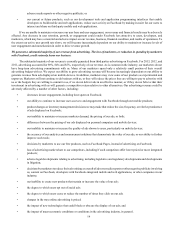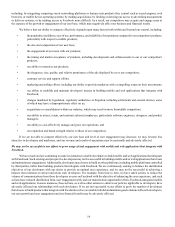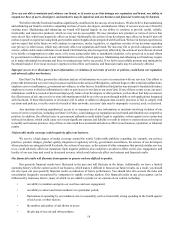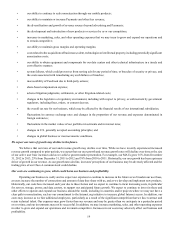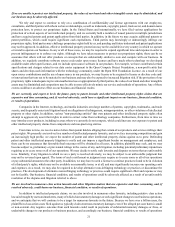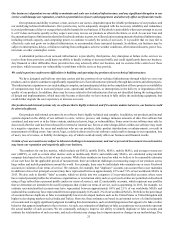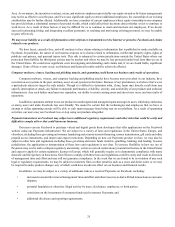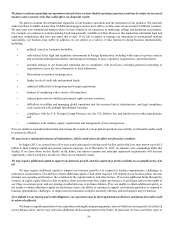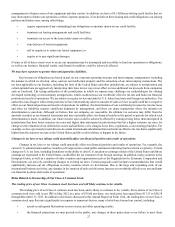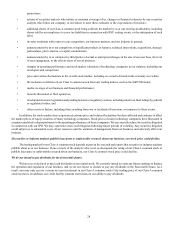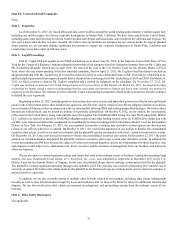Facebook 2013 Annual Report Download - page 25
Download and view the complete annual report
Please find page 25 of the 2013 Facebook annual report below. You can navigate through the pages in the report by either clicking on the pages listed below, or by using the keyword search tool below to find specific information within the annual report.23
Our business is dependent on our ability to maintain and scale our technical infrastructure, and any significant disruption in our
service could damage our reputation, result in a potential loss of users and engagement, and adversely affect our financial results.
Our reputation and ability to attract, retain, and serve our users is dependent upon the reliable performance of our products and
our underlying technical infrastructure. Our systems may not be adequately designed with the necessary reliability and redundancy
to avoid performance delays or outages that could be harmful to our business. If Facebook is unavailable when users attempt to access
it, or if it does not load as quickly as they expect, users may not use our products as often in the future, or at all. As our user base and
the amount and types of information shared on Facebook continue to grow, we will need an increasing amount of technical infrastructure,
including network capacity, and computing power, to continue to satisfy the needs of our users. It is possible that we may fail to
effectively scale and grow our technical infrastructure to accommodate these increased demands. In addition, our business may be
subject to interruptions, delays, or failures resulting from earthquakes, adverse weather conditions, other natural disasters, power loss,
terrorism, or other catastrophic events.
A substantial portion of our network infrastructure is provided by third parties. Any disruption or failure in the services we
receive from these providers could harm our ability to handle existing or increased traffic and could significantly harm our business.
Any financial or other difficulties these providers face may adversely affect our business, and we exercise little control over these
providers, which increases our vulnerability to problems with the services they provide.
We could experience unforeseen difficulties in building and operating key portions of our technical infrastructure.
We have designed and built our own data centers and key portions of our technical infrastructure through which we serve our
products, and we plan to continue to significantly expand the size of our infrastructure primarily through data centers and other projects.
The infrastructure expansion we are undertaking is complex, and unanticipated delays in the completion of these projects or availability
of components may lead to increased project costs, operational inefficiencies, or interruptions in the delivery or degradation of the
quality of our products. In addition, there may be issues related to this infrastructure that are not identified during the testing phases
of design and implementation, which may only become evident after we have started to fully utilize the underlying equipment, that
could further degrade the user experience or increase our costs.
Our products and internal systems rely on software that is highly technical, and if it contains undetected errors, our business could
be adversely affected.
Our products and internal systems rely on software that is highly technical and complex. In addition, our products and internal
systems depend on the ability of our software to store, retrieve, process, and manage immense amounts of data. Our software has
contained, and may now or in the future contain, undetected errors, bugs, or vulnerabilities. Some errors in our software may only be
discovered after the code has been released for external or internal use. Errors or other design defects within our software may result
in a negative experience for users and marketers who use our products, delay product introductions or enhancements, or result in
measurement or billing errors. Any errors, bugs, or defects discovered in our software could result in damage to our reputation, loss
of users, loss of revenue, or liability for damages, any of which could adversely affect our business and financial results.
Certain of our user metrics are subject to inherent challenges in measurement, and real or perceived inaccuracies in such metrics
may harm our reputation and negatively affect our business.
The numbers for our key metrics, which include our DAUs, mobile DAUs, MAUs, mobile MAUs, and average revenue per
user (ARPU), as well as certain other metrics such as mobile-only DAUs and mobile-only MAUs, are calculated using internal
company data based on the activity of user accounts. While these numbers are based on what we believe to be reasonable estimates
of our user base for the applicable period of measurement, there are inherent challenges in measuring usage of our products across
large online and mobile populations around the world. For example, there may be individuals who maintain one or more Facebook
accounts in violation of our terms of service. We estimate, for example, that "duplicate" accounts (an account that a user maintains
in addition to his or her principal account) may have represented between approximately 4.3% and 7.9% of our worldwide MAUs in
2013. We also seek to identify "false" accounts, which we divide into two categories: (1) user-misclassified accounts, where users
have created personal profiles for a business, organization, or non-human entity such as a pet (such entities are permitted on Facebook
using a Page rather than a personal profile under our terms of service); and (2) undesirable accounts, which represent user profiles
that we determine are intended to be used for purposes that violate our terms of service, such as spamming. In 2013, for example, we
estimate user-misclassified accounts may have represented between approximately 0.8% and 2.1% of our worldwide MAUs and
undesirable accounts may have represented between approximately 0.4% and 1.2% of our worldwide MAUs. We believe the percentage
of accounts that are duplicate or false is meaningfully lower in developed markets such as the United States or United Kingdom and
higher in developing markets such as India and Turkey. However, these estimates are based on an internal review of a limited sample
of accounts and we apply significant judgment in making this determination, such as identifying names that appear to be fake or other
behavior that appears inauthentic to the reviewers. As such, our estimation of duplicate or false accounts may not accurately represent
the actual number of such accounts. We are continually seeking to improve our ability to identify duplicate or false accounts and
estimate the total number of such accounts, and such estimates may change due to improvements or changes in our methodology. Due



